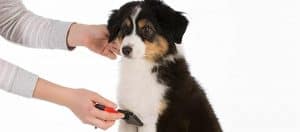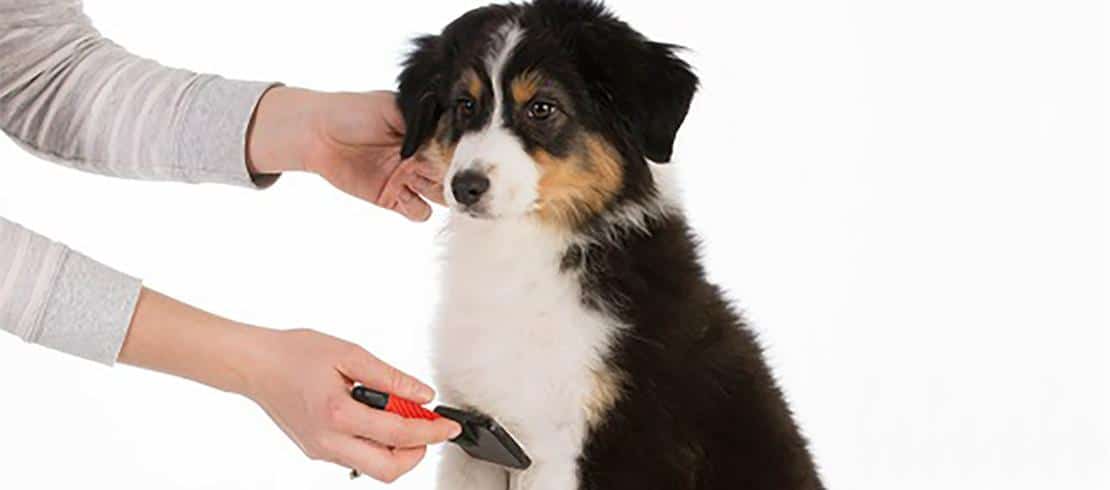Here’s a few tips on how to handle a puppy coat when it comes to grooming. Puppies go through many developmental changes within the first year of their lives, including the change from a puppy coat to an adult coat. In both males and females, the coat changes somewhere between the ages of nine and twelve months.
Before the puppy reaches this age, the coat is in its first growing cycle and, regardless of the coat type, it is most likely that the coat will have an extra thick undercoat. The puppy coat also appears to have extra waterproofing properties; this is, of course, to keep the puppy warm during his development.
Whether it actually is more waterproof, or whether it appears so simply because the coat has a different texture from that of the adult is difficult to determine for sure. You will discover, however, from experience that it is more difficult to soak a puppy coat than it is an adult coat!
A puppy coat is very easy to look after as even a long coat will not knot up easily and there is no molting undercoat to worry about. You can use this to your advantage! The puppy needs to get used to being groomed and it will be much easier to convince him that grooming is a good experience if you do not have to work for hours removing knots and tangles on his first time.
Arrange for the puppy to be groomed daily by the owner and every couple of weeks by a groomer for just a few minutes so that the sessions are short and frequent and become an ‘everyday, nothing-to-worry-about routine’.
It is a good idea to get the puppy used to having baths and accustomed to a hair-dryer. Modern shampoos are formulated to be kind to the skin so bathing will not do any harm and it is best to make the experience a familiar one whilst the puppy is at a manageable size.
In contrast, as the puppy coat reaches the end of its first growing cycle and begins to change to an adult coat, it becomes much more difficult to look after, and this unfortunately remains the case until the c oat change has been completed.
oat change has been completed.
When the coat starts to change, molting breeds lose some of the undercoat hairs. Other coats that do not molt change color, becoming lighter and faded, and they also change in texture, becoming dry and lifeless.
The skin at this point may well be slightly traumatized because, as with many other new developments the dog experiences as he grows up, the coat change is a ‘first time’ event and the skin has to adapt, so take extra care when grooming out.
Changing smooth coats are the easiest to recognize because the coat molts for the first time and loose hairs will appear around the house. Some undercoat comes away first, soon followed by a portion of topcoat hair. The coat replenishes itself almost immediately and retains its glossy character.
Silk coats lose their lustre and the coat becomes dry and brittle, and breaks easily. Knotting will begin if the coat is not groomed, and as the knots are groomed out, the hairs break easily somewhere along their length.
The problem this poses is that the hairs are then all of different lengths and it is thus more likely that the coat will continue to knot up as the different length hairs move against each other.
When double coats experience their first major molt, it is likely to be a huge molt — remember that there is more undercoat to come away than normal. This can sometimes be unexpected because it is not always governed by a seasonal change.
It may also be a hormonal change. If a bitch puppy has her first season in a wintry November, she may have her first molt to coincide with the time she would be having puppies if she were mated – about nine to ten weeks later, around the end of January.
It is not unusual for bitches particularly to lose nearly all of their undercoat, leaving a very sparse covering. This is normal for a first molt, but it is just as normal for the molt occasionally to be very insignificant. You do not need to worry too much, but should be more concerned if things appear abnormal at a second molt.
Heavily coated male dogs may not be overly affected by seasonal changes if the climate is mild, so again the molt can occur when the dog reaches maturity rather than according to the weather. The undercoat needs to be removed as soon as it starts to come away.
Wool coats are the most problematic. The puppy wool coat is incredibly soft, light and buoyant. Before the coat change it is quite glossy, and even when dirty it rarely knots significantly, although it may take on an odor. This coat does not molt but it does die, and it loses all of its glossiness, becoming sticky, dull and lifeless.
Then it knots up, mats up, forms wadding, smells and … it will do all of this within a few hours of grooming – every day, for weeks!
This happens because the coat is predominantly undercoat and, as with the other coat types, there is a lot of undercoat wanting to come out but unable to do so. It has to be groomed out and this can only be done once the hairs have become fragile enough to come away from the hair follicle.
An added problem is that, whilst the old hairs are dying, new hairs are already growing from the same follicles; if left ungroomed, the two coats (old and new) merge and can become troublesome, resulting in the obliteration of the daily grooming effort!
Perseverance is the answer if you want to keep the coat long, otherwise this is one occasion where most owners often ask for the coat to be removed. On the bright side, it will grow again — very quickly.
Wire topcoats die, fade and start to curl and separate. This normally starts to happen at around five months of age but it does depend very much on the breed. The dying hairs need to be removed or they may obstruct the new coat trying to grow through the same follicles.
On wire-coated breeds that grow furnishings, the longer hair may not reach its full length until the puppy is around a year old and, as the coat reaches this stage it may start to knot up in places, although it is more likely that slight wadding will occur because of the presence of dead undercoat.
Puppies differ greatly in their development according to their breed but, generally speaking, all puppies begin adolescence once their adult teeth are in place, so coat changing can begin any time after about five or six months of age.
It is commonly thought that clipping a puppy coat off too soon may damage the coat, although this is not possible because the coat grows from the inside out, so the growing roots cannot be reached to be damaged, and that clipping the coat changes the structure of the coat. There are two main reasons for this:
- Clipping silk and wool coats encourages the coat to grow thicker simply because the hairs will be stronger and will not break or be damaged as easily as hairs that have been left to grow and become brittle or weaken with age.
- Clipping wire coats makes the coat thicker and possibly paler in color. The coat might also appear softer and may even continue to grow with a curl to the hairs. If the coat is left to molt out and regrow, it can more often than not be returned to its correct texture, although this could take quite a few months.
With this in mind, it is always best to confirm with the owner whether the dog is destined to be a pet or a show dog, and whether the puppy is going to be styled traditionally (hand plucking) or pet trimmed.

